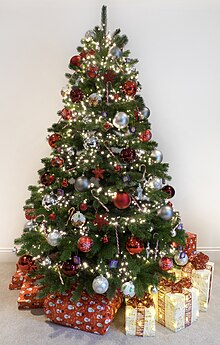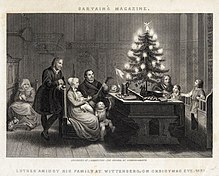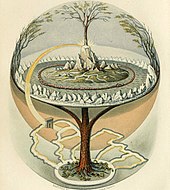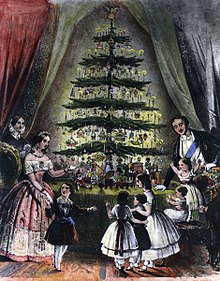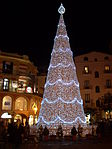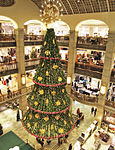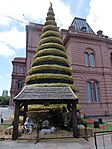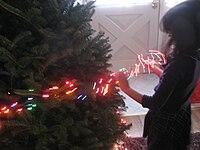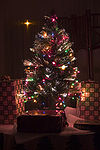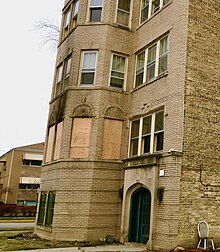
Advent is a season observed in most Christian denominations as a time of expectant waiting and preparation for both the celebration of the Nativity of Christ at Christmas and the return of Christ at the Second Coming. Advent is the beginning of the liturgical year in Western Christianity. The name was adopted from Latin adventus, translating the Greek parousia from the New Testament, originally referring to the Second Coming.

A wreath is an assortment of flowers, leaves, fruits, twigs, or various materials that is constructed to form a ring shape.

The Advent wreath, or Advent crown, is a Christian tradition that symbolizes the passage of the four weeks of Advent in the liturgical calendar of the Western church. It is traditionally a Lutheran practice, although it has spread to many other Christian denominations.
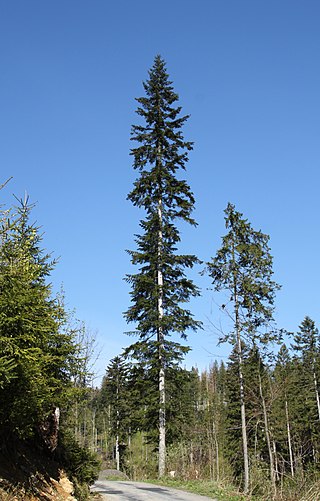
Abies alba, the European silver fir or silver fir, is a fir native to the mountains of Europe, from the Pyrenees north to Normandy, east to the Alps and the Carpathians, Slovakia, Slovenia, Croatia, Bosnia and Herzegovina, Montenegro, Serbia, and south to Italy, Bulgaria, Kosovo, Albania and northern Greece.

Christmas lights are lights often used for decoration in celebration of Christmas, often on display throughout the Christmas season including Advent and Christmastide. The custom goes back to when Christmas trees were decorated with candles, which symbolized Christ being the light of the world. The Christmas trees were brought by Christians into their homes in early modern Germany.

The Fraser fir, sometimes spelled Frasier fir, is an endangered species of fir native to the Appalachian Mountains of the Southeastern United States. They are endemic to only seven montane regions in the Appalachian Mountains.

A Christmas decoration is any of several types of ornamentation used at Christmastide and the greater holiday season. The traditional colors of Christmas are pine green (evergreen), snow white, and heart red. Gold and silver are also prevalent, as are other metallic colours. Typical images on Christmas decorations include Baby Jesus, Mother Mary, angels, Father Christmas, Santa Claus, and the star of Bethlehem. Advent wreaths, nativity scenes, illuminations, and Moravian stars are popular Christmas decorations.

New Year trees are decorated trees similar to Christmas trees that are displayed to specifically celebrate the New Year. They should not be confused with the practice of leaving up a Christmas tree until after New Year's Day. New Year trees are common in various cultures and nations, chiefly the former Soviet Union, former Yugoslavia, Turkey, China and Vietnam.

Candlemas, also known as the Feast of the Presentation of Jesus Christ, the Feast of the Purification of the Blessed Virgin Mary, or the Feast of the Holy Encounter, is a Christian feast day commemorating the presentation of Jesus at the Temple by Joseph and Mary. It is based upon the account of the presentation of Jesus in Luke 2:22–40. According to the Old Testament rules in Leviticus 12, a woman was to be purified by presenting a lamb as a burnt offering, and either a young pigeon or dove as sin offering, 33 days after a boy's circumcision. The feast falls on 2 February, which is traditionally the 40th day of and the conclusion of the Christmas–Epiphany season.

An Advent candle is a candle marked with the days of December up to Christmas Eve. It is typically used in a household rather than a church setting: each day in December the candle is burnt down a little more, to the mark for the day, to show the passing of the days leading up to Christmas. As with reusable Advent calendars, some Advent candles start marking the days from 1 December, rather than the exact beginning of Advent. Some households will make a Christmas decoration out of sprigs of evergreen and Christmas ornaments, with the candle at its center; others will simply put it in a candlestick. It is usually burned at the family evening meal each day.

Christmas pyramids are Christmas decorations that have their roots in the folklore and customs of the Ore Mountain region of Germany, but which have become popular internationally. They comprise a decorated pyramidal outer frame with candle holders and a central carousel with a rotor at the top which is driven by warm air from the lit candles. The carousel is decorated with nativity scenes and other Christmas figures such as angels and wise men, as well as worldly motifs such as mining folk and forest scenes.
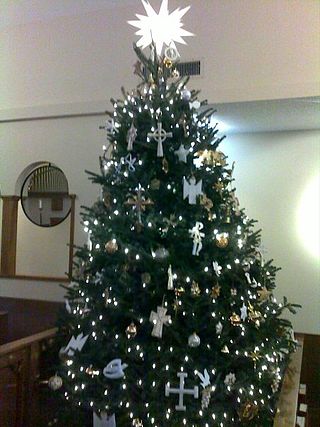
A Chrismon tree is an evergreen tree often placed in the chancel or nave of a church during Advent and Christmastide. The Chrismon tree was first used by North American Lutherans in 1957, although the practice has spread to other Christian denominations, including Anglicans, Catholics, Methodists, and the Reformed. As with the ordinary Christmas tree, the evergreen tree itself, for Christians, "symbolizes the eternal life Jesus Christ provides". However, the Chrismon tree differs from the traditional Christmas tree in that it "is decorated only with clear lights and Chrismons made from white and gold material", the latter two being the liturgical colours of the Christmas season.

The National Christmas Tree is a large evergreen tree located in the northeast quadrant of the Ellipse near the White House in Washington, D.C. Each year since 1923, the tree has been decorated as a Christmas tree. Every year, early in December, the tree is traditionally lit by the President and First Lady of the United States. Every president since Franklin D. Roosevelt has also made formal remarks during the tree lighting ceremony.
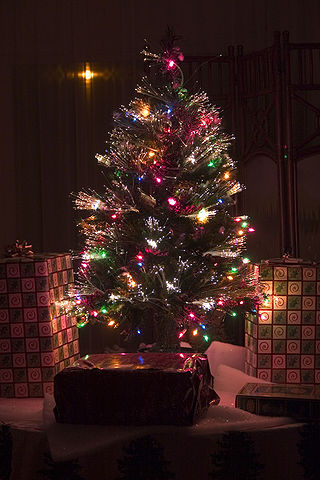
An artificial or fake Christmas tree is an artificial pine or fir tree manufactured for the specific purpose of use as a Christmas tree. The earliest artificial Christmas trees were wooden, tree-shaped pyramids or feather trees, both developed by Germans. Most modern trees are made of polyvinyl chloride (PVC) but many other types of trees have been and are available, including aluminum Christmas trees and fiber-optic illuminated Christmas trees.
Christmas plants are flowers or vegetation from garden plants associated with the festive season of Christmas. There are also a wide variety of plants that include "Christmas" in their common name.

The Legend of the Christmas Spider is an Eastern European folktale which explains one possible origin of tinsel on Christmas trees. It is most prevalent in Western Ukraine, where small ornaments in the shape of a spider are traditionally a part of the Christmas decorations.

The hanging of the greens is a Western Christian ceremony in which many congregations and people adorn their churches, as well as other buildings, with Advent and Christmas decorations. This is done on or directly before the start of the Advent season, in preparation for Christmastide. The service involves the placement of evergreen vegetation in the parish. Items such as the evergreen wreath, in Christianity, carry the religious symbolism of everlasting life, a theological concept within that faith. As such, during the liturgy, "Biblical passages and other readings help explain the significance of the holly, the cedar, the Advent wreath, the Chrismon tree, and any other special decorations". Christmas trees are frequently erected during the hanging of the greens, although they are sometimes left bare until Christmas Eve.

Christmas in France is a major annual celebration, as in most countries of the Christian world. Christmas is celebrated as a public holiday in France on December 25, concurring alongside other countries.

Christmas traditions include a variety of customs, religious practices, rituals, and folklore associated with the celebration of Christmas. Many of these traditions vary by country or region, while others are practiced virtually identically worldwide.

Podłaźniczka, polazňička is a traditional Polish and Slovak Christmas decoration. It was usually made from branches or the top of a conifer tree turned upside down, which was then decorated with colored paper cutouts (wycinanki), candies, apples, nuts, typical Polish świats, or stars and crosses made of straw. The podłaźniczka was then hung from the ceiling rafters over the Wigilia dinner table on Christmas Eve.
